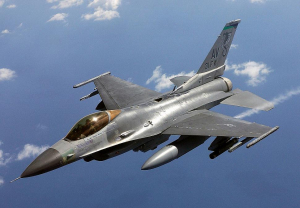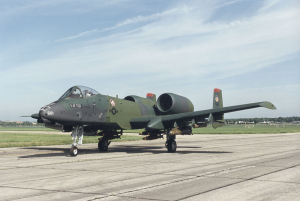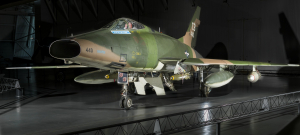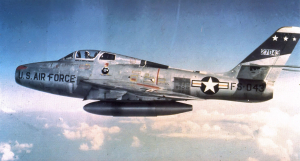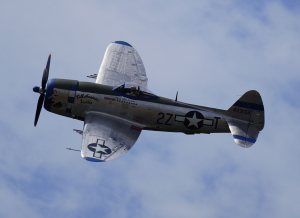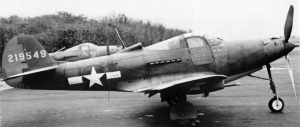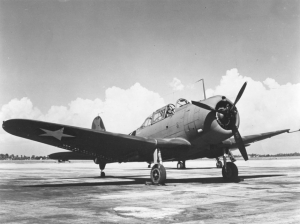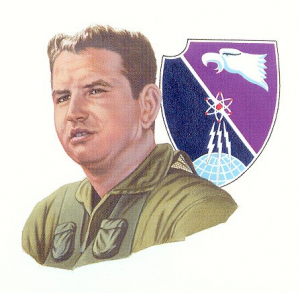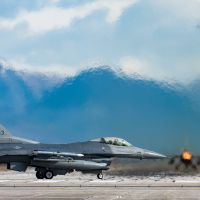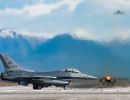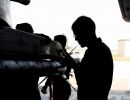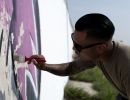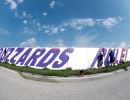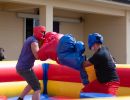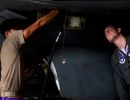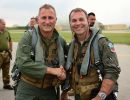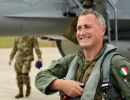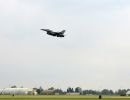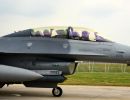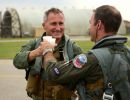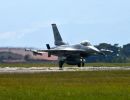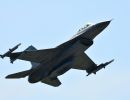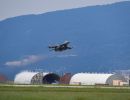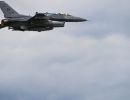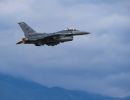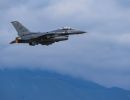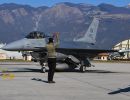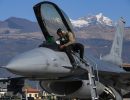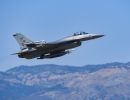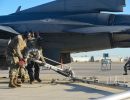
David Sarvai
General Dynamics F-16C Fighting Falcon
The F-16 Fighting Falcon is a compact, multirole fighter aircraft. It is highly maneuverable and has proven itself in air-to-air combat and air-to-surface attack. It provides a relatively low-cost, high-performance weapon system for the United States and allied nations.
Fairchild-Republic A-10A Warthog
The A-10 and OA-10 Thunderbolt IIs are the first Air Force aircraft specially designed for close air support of ground forces. They are simple, effective and survivable twin-engine jet aircraft that can be used against all ground targets, including tanks and other armored vehicles. The primary mission of the A-10 is to provide day and night close air combat support for friendly land forces and to act as forward air controller (FAC) to coordinate and direct friendly air forces in support of land forces. The A-10 has a secondary mission of supporting search and rescue and Special Forces operations. It also possesses a limited capability to perform certain types of interdiction. All of these missions may take place in a high or low threat environment.
North American F-100D Super Sabre
The F-100 was the USAF's first operational aircraft capable of flying faster than the speed of sound (760 mph) in level flight. The F-100 is best remembered for the years it spent on the United States Air Force Thunderbirds aerial demonstration team. The F-100 achieved distinction as the world’s first production aircraft capable of flying faster than the speed of sound. The Super Sabre made its combat debut in Vietnam where it performed a fighter-bomber role in ground support missions. The F-100 measured 54 feet two inches long, 16 feet two inches high, and weighed 38,048 pounds. The $704,000 Super Sabre reached a top speed of 926.6 MPH and reached a cruising range of 1,970 miles.
Republic F-84F Thunderstreak
The Republic F-84, like the subsequent F-105 Thunderchief, was a descendant of the first bearer of the "Thunder" name, the company's P-47 Thunderbolt, famed "jug" of World War II Conceived as a jet successor to the Thunderbolt and first designated the P-84, the F-84 was designed around the General Electric TG-180 (J-35) turbojet and was of straightforward design and construction.
Republic P-47 Thunderbolt
Toward the end of WW II, better than 40 percent of all AAF fighter groups serving overseas were equipped with the rugged P-47s. Single-engined, single-seat escort fighter and fighter-bomber. Conceived, tested, produced, and put into action wholly within the period of World War II. P-47 Thunderbolts (F-47Ds and F-47Ns) equipped SAC, TAC, and ADC squadrons for a number of postwar years. They subsequently reached the Air National Guard and did not pass out of service until 1955. The F-47 was the Air Force's last radial-engine fighter.
Bell P-39C Airacobra
In 1937, the Army Air Corps issued a specification for a new fighter that could be produced quickly. Other competing designs included the Curtiss P-40, an outgrowth of a previous design, and the Lockheed P-38, which utilized a complex twin-engine twin boom configuration. Although Bell's limited fighter design work had previously resulted in the unusual Bell YFM-1 Airacuda, the Model 12 proposal adopted an equally original configuration with an V12 Allison engine mounted in the middle of the fuselage, just behind the cockpit, with the propeller driven by a shaft passing beneath the pilot's feet (under the cockpit floor).
Douglas A-24 Banshee
The Douglas A-24 was the Army's version of the Navy SBD carrier-based dive bomber. It was almost identical to its Navy counterpart, but the Army's A-24 never achieved the degree of success and immortality as did the SBD. Its relative lack of success in combat led to its early withdrawal from operational service and its relegation to training and other support roles.
MG Robert L. Delashaw
Major General Robert Lee Delashaw, U.S. Air Force (Ret.) made his "last take-off" to join up with his maker on February 24, 2012 in San Antonio, Texas. He was born in Whitesboro, Texas on December 20, 1914. He served in the US Navy between 1933 and 1937 and then enlisted in the US Army in 1939. He graduated from flying training in 1940 as a Second Lieutenant and embarked on a fulfilling 29 year career culminating in his retirement in 1969. He always felt he was fortunate to have worked with the best pilots and airmen in the world. Those same people said he was a great leader of men and never asked of them that which he would not do himself.
Gen Ronald R. Fogleman
As a young fighter pilot, Ronald R. Fogleman proved his mettle during two combat tours over Southeast Asia where he flew 806 hours on 315 combat missions.
Lt Col David C. Nichols
Lt Col David C. Nichols was born on 12 March 1959 in Ann Arbor, Michigan. In 1977, he graduated from Ann Arbor Pioneer High School and earned a Bachelor of Science Degree from the United States Air Force Academy in 1981. He then completed a Master of Science in Systems Management from St Mary’s University in 1986. He has completed Squadron Officers School and Marine Corps Command and Staff College. He graduated from Air Command and Staff College in May of 1994 and Armed Forces Staff College in September of that year.

